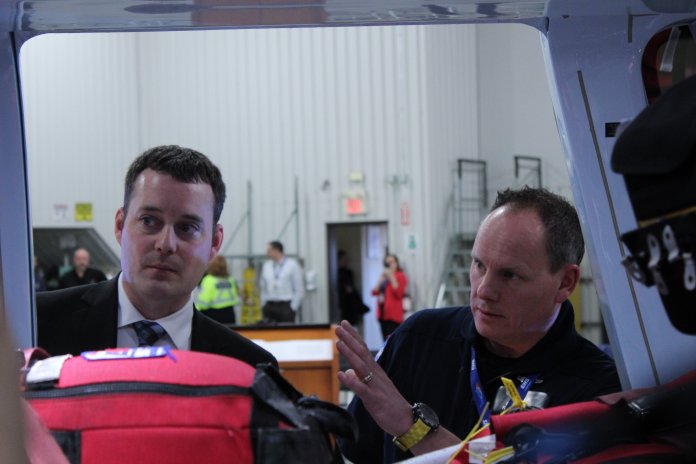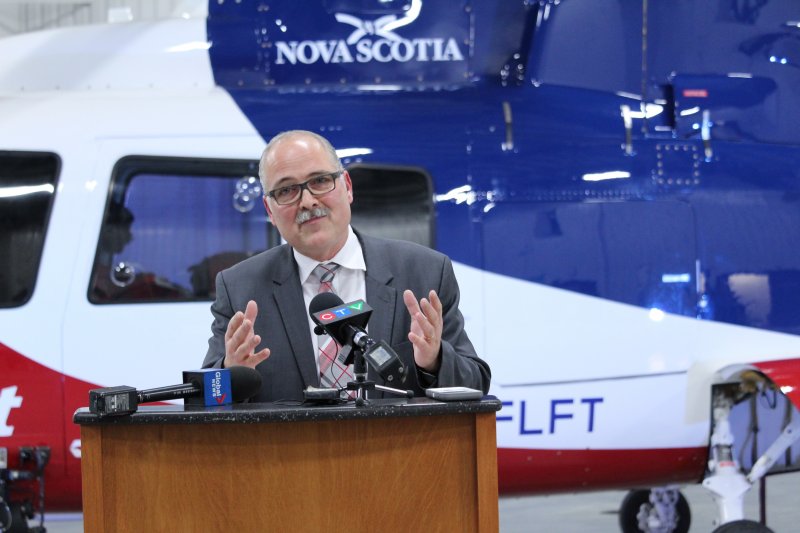
HALIFAX STANFIELD: Having two new medical Lifeflight helicopters now in operation is a relief to Nova Scotia’s Health and Wellness Minister and EHS Lifeflight.

The much anticipated unveiling of the two new Sikorsky S-76 C helicopters—delayed by almost two months due to certification requirements from Transport Canada—took place Dec. 20 inside the EHS Lifelfight hangar on Barnes Drive. One of the helicopters was out on a call so it wasn’t at the unveiling announcement.
Health and Wellness Minister Randy Delorey said it’s a relief to finally see the new Canadian Helicopters Ltd. (CHL)-built Lifeflight helicopters in operation; they began service on Dec. 15, and have already made several calls. Previously, EHS had one helicopter—now as part of this new purchase they have two.
“It certainly is a very exciting time for all Nova Scotians, particularly those with the Lifeflight team and all of the medical teams that respond to these type of emergencies,” said Delorey in response to a question from The Weekly Press in a media scrum. “With the enhancements that come with the new helicopter, not just getting them back on the rooftop landings at the IWK and QE II, they have more powerful engines and can operate in more intense weather conditions, they can go a little bit faster.
“All of these things, more space for the crew and patient, all of these things are great benefits that come with the new helicopters.”
One of the issues with the old helicopters was that they were no longer allowed to land on helipads at the IWK and QE II hospitals, due to a rule change by Transport Canada. This resulted in the helicopters landing at Point Pleasant Park and then a ground ambulance would transport the patients. With the new helicopters, the resumption of landing at the helipads at the hospitals is underway.
Delorey said while they could not land at the hospitals for 20 months, it was important to note that the crew did respond to calls and safety of those in need was never at risk.

LifeFlight Tango and LifeFlight November have innovative technology that exceeds any emergency medical aircraft in use in Canada currently.
Among the features on the new helicopters include: a state-of-the-art navigation and communication systems that improve safety, including automatic voice alerts, surveillance, and real-time Environment Canada weather feed – the first of its kind in Canada; back-up life-saving equipment, like oxygen outlets and regulators, and a back-up generator to fuel that equipment; a night vision goggle-compatible cockpit; and climate control that provides a better environment for the
Delorey said Lifeflight is a crucial part of the provincial emergency medical services. The price tag for the 15-year deal between the province and CHL is $105 million.
“These new helicopters can get patients to hospital faster and have important equipment available to critical care teams when they need it most,” he said.
Colin Flynn, program manager EHS LifeFlight, said they’re pleased to have both helicopters now in service.
“It was a long process but a much-needed process to be able to land on the rooftop helipads again,” said Flynn.

Vice President and Chief Operating Officer for CHL, Sylvain Seguin, spoke about working closely with the Lifeflight team to make sure the chopper met their needs.
“As we were working with the committee and finding the best way to make these aircraft the best we could as a team, some of these changes that came up just caused a further delay on the certification,” said Seguin in a media scrum. “At the end of the day, the aircraft were physically able to go — we ended up waiting on documentation on paperwork on certification.”
EHS received its final certification from Transport Canada at 5:30 p.m. on Dec. 15. Two hours later, it was on its way to its first call.







